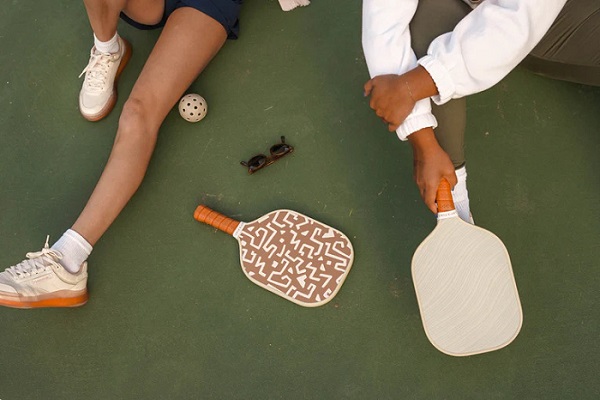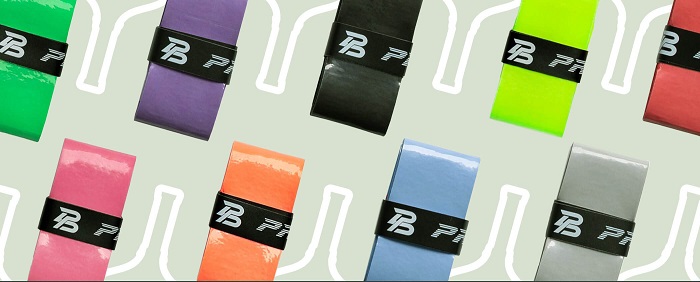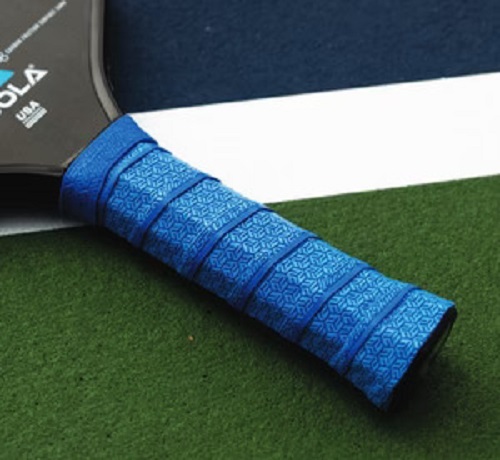If you’re looking to improve your game of pickleball, one of the best things you can do is regrip your paddle. It’s a simple process that will provide better control and more comfort while playing. The grip helps absorb shock and allows for better racket head speed so you can make quick shots.
In this guide, we’ll go through step-by-step instructions on how to regrip a pickleball paddle correctly. You’ll need a few tools such as a utility knife, sandpaper, adhesive tape, and grip material to complete the job. With just these few items, you can turn an ordinary paddling experience into something extraordinary.

A Step-by-step Guide to Changing Your Paddle Grip
Regripping your pickleball paddle is easier than you think. You just need to follow some steps which are mentioned below, and you are good to play.
Gather the Materials
Materials:
- pickleball paddle tape
- Rubbing alcohol
- Clean cloth
Tools:
- Razor blade or scissors
- Gripping clamp or vice
- Heat gun or hair dryer (optional)
Ensure a successful regripping process by having the right tools and materials, including grip pickleball paddle tape for necessary traction and comfort. To ensure proper adhesion of the grip tape, clean the handle with rubbing alcohol and a clean cloth.
Securely hold the paddle with a gripping clamp or vice while cutting the grip tape to the appropriate length and shape with either a razor blade or scissors. This will help ensure an even application of grip tape that won’t shift during installation.
Using a heat gun or hair dryer can make the grip tape adhere to the handle more securely, but it is not necessary. In fact, you should use caution when exposing your paddle to excessive heat as this could cause damage.
Having the right tools and materials is key to a successful regripping process. With the proper equipment, you can guarantee that your grip tape will adhere securely to your paddle and offer you the necessary comfort and traction while playing. Don’t rely on makeshift or substandard supplies; make sure to invest in quality items to get optimal results.
Remove the Old Grip
- Use a sharp utility knife or grip removal tool to cut through the old grip lengthwise.
- Slowly peel the grip off the paddle, being careful not to damage the underlying foam or handle.
- Remove any remaining adhesive residue using a solvent such as rubbing alcohol or acetone.
- Allow the handle to dry completely before proceeding to the next step.
Note: if the old grip was wrapped over an overgrip, remove the overgrip first before removing the main grip.
Prepare the Paddle for the New Grip
- Start by making sure that the paddle grip is clean and free from dirt or debris.
- Check for any signs of wear, tear, or damage to the existing grip before beginning. If any are found, replace them with a new grip before continuing.
- If replacing the old grip with a new one, use an adhesive spray to secure it in place on the handle of the paddle. Make sure that it is evenly spread around so there are no air pockets between the handle and the new grip surface. Here, I have mentioned how to wrap a pickleball paddle
- Once in place securely, wrap twine around where your palm will go when gripping onto the handle (this helps add extra traction). Wrap tightly but not too tight as this could affect your performance when playing pickleball!
- After you have finished wrapping twine around your palm area then take some athletic tape and wrap it over the top of both layers to ensure they stay put during playtime! Again make sure you apply enough pressure so that neither layer slips out from underneath during playtime!
- Adjust accordingly if needed until everything feels comfortable and secure in hand – just like a glove should fit comfortably on your hand.

Apply the New Grip
- Start at the bottom of the handle and make sure the grip is even with the butt end of the paddle.
- Wrap it around, making sure it’s straight, and pull firmly as you go so that it fits snugly.
- Overlap each layer by about 1/8 inch (3mm) to ensure a smooth finish without any gaps or bubbles.
- When you reach the top, secure it with a rubber band or grip tape and let dry for 24 hours before using.
Finishing Touches
To finish off the hold with a professional look, use a sharp utility knife or grip-trimming tool to trim away any excess fabric at the top and base.
An optional finishing video can be applied over the grip for extra safety and durability. When you’re done, remember to wash your paddle and store it in a calm, dry place until your following game.
If you want to see it virtually then you can check this YouTube Tutorial.
When Should You Change Your Grip?
If you notice any of the following, you should change your paddle grip:
- The grip feels silky instead of tacky.
- The grip twists in your hand after driving or smashing the ball. Note that this could also indicate that you’re using a grip that’s too small.
- You accidentally let go of the paddle and it flung across the court like a boomerang of death.
- You simply want to change the grip for fun, which is perfectly fine.
Regripping your paddle can be fun, but you’re probably here because you want to restore the tackiness that’s been lost. Unfortunately, the lifespan of a tacky grip is relatively short. In my experience, grips tend to lose their tackiness after about 100-150 hours of playtime. This is just an estimate, as the lifespan may vary depending on your experience. In other words, if you want that great tacky feeling in your hands all the time, you’ll have to change your grip frequently.
However, you don’t necessarily have to change the grip entirely. Applying an overgrip to the paddle handle is another great option for restoring tackiness. This is an even better option if you want to slightly thicken the grip. By doing so, you won’t have to replace the entire grip, which is what I typically do.
Know more about kids pickleball paddle
Over-gripping Your Paddle
If you need extra thickness or tackiness but don’t want to change your grip, over-gripping can be a great option. As the name suggests, an overgrip is applied directly onto your existing grip. This is my preferred method for adding tackiness to my paddle grip.
Overgrips come in a wide range of colors, depending on the brand you choose. There’s nothing wrong with adding some flair to your grip!

Applying an overgrip to your paddle isn’t much different from replacing the grip entirely. The only difference is that overgrips have one piece of adhesive near the tip of the strip, and the rest isn’t adhesive. This makes over-gripping much more forgiving than replacing the grip entirely because you can easily redo it if you mess up.
However, it can be challenging to make the grip uniformly tight. I had to ask someone to take these pictures for me because I couldn’t take my hands off my paddle.
Here’s the overgrip tape we’re using today. Simply unravel it, set aside the sticky tape, and you’re good to go.
Deepen your insight on illegal pickleball paddles
FAQs
Regripping your pickleball paddle can enhance your grip and control over the paddle, leading to better execution on the court. Besides, over time, the grip on your paddle can become worn or injured, making it less satisfying and less effective.
The frequency of regripping your paddle on how frequently you play and the shape of the grip. Generally, it is recommended to regrip your paddle at least once a year or more frequently if you play frequently.
To install the new grip, start by washing the paddle surface and ensuring that it is dry. Then, peel off the backing of the grip and wrap it tightly around the paddle, beginning at the butt end and operating your way toward the head. Use scissors to trim any extra grip.
Regripping your pickleball paddle is a relatively straightforward procedure that can be done at home with the right tools and instructions. However, if you are unsure or uncomfortable with the process, it is always a good concept to seek the help of an experienced to confirm that the grip is installed correctly.
In most cases, it is not recommended to reuse the grip from an old pickleball paddle. Over time, the grip can become stretched, damaged, or contaminated, making it less effective and less hygienic. It is generally best to use a new grip when regripping your paddle.
Final Thoughts – How to Regrip a Pickleball Paddle
In conclusion, you know now how to regrip a pickleball paddle, it is a simple and essential maintenance task that every pickleball player should know how to do. By following the step-by-step instructions in this guide, you can easily remove the old grip, prepare the handle, use the new grip, and finish the paddle for a professional look.
With a new grip on your paddle, you can enjoy enhanced grip, comfort, and performance on the court. Remember to use the proper tools and materials, take your time, and allow the grip to parch completely before using the paddle. By regripping your pickleball paddle regularly, you can prolong its lifespan and enjoy a better game every time.



